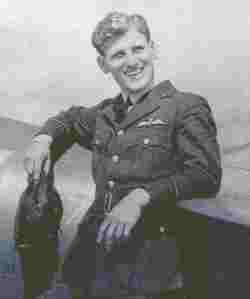Dowse, Sydney Hastings
- Date of birth:
- November 21st, 1918
- Date of death:
- April 10th, 2008
- Service number:
- 86685
- Nationality:
- British
Biography
Sydney Dowse enlisted in the RAF Volunteer Reserve as an airman in 1937 and was commissioned in 1940. Initially he was posted to No. 608 Squadron, flying convoy and anti-submarine operations. He then joined No. 1 Photo Reconniassance Unit. During a mission while filming the German battle cruisers Gneisenau and Scharnhorst over Brest he was shot down but managed to bail out of his aircraft.
Following his capture he made 5 escape attepts including during The Great Escape. He was subsequently sent to Sachsenhausen where he remained until the camp was liberated in May 1945.
He left the RAF after the war
Dowse served as an equerry at Buckingham Palace and had a long and successful career as a civil servant. For a number of years in the 1950s, at the time of the communist insurgency, he served in Malaya as assistant secretary to the Penang Settlement. In 1966 Dowse and his colleagues sought compensation for those who had suffered in concentration camps. The Foreign Office claimed that the RAF men were "held under conditions which could not be equated to those of concentration camps proper". Airey Neave MP, who had escaped from Colditz, led the protests. After an acrimonious debate in Parliament a lengthy inquiry was held, and two years later the Ombudsman found in favour of 12 British servicemen who had been imprisoned in Sachsenhausen, including the RAF men.
Even though Dowse endured much hardship during the war he once remarked: "Once one escapes from [Sachsenhausen], life holds no difficulties."
He was three times married. There were no children.
Promotions:
October 21st, 1940: Pilot Officer (probation)
October 21st, 1941: Flying Officer (war sub)
October 21st, 1942: Flight Lieutenant (war sub)
Do you have more information about this person? Inform us!
- Period:
- Second World War (1939-1945)
- Rank:
- Flying Officer
- Awarded on:
- June 11th, 1942
- Period:
- Second World War (1939-1945)
- Rank:
- Flight Lieutenant
- Unit:
- No. 608 (North Riding) Squadron, Royal Air Force
- Awarded on:
- August 16th, 1948
"Flight Lieutenant Dowse was captured by the Germans at Brest in August, 1941, after he had abandoned his aircraft which had been set on fire by enemy fighters. Throughout his captivity, this officer persistently tried to escape but never succeeded in reaching England. In December, 1941, he escaped from a hospital at Stadtroda to which he had been taken after capture for treatment for an injured leg. Three days later, he was caught by a frontier guard at the German-Dutch border. Flight Lieutenant Dowse later escaped from a camp at Bad Suiza by mingling with a fatigue party. After travelling by train to Werwitz, he continued on foot, through deep snow towards the German-Belgian frontier where he was eventually captured, suffering from extreme exhaustion. After some days in hospital, Flight Lieutenant Dowse was imprisoned at Oflag VIB. Whilst there he was engaged in the construction of four tunnels from one of which six officers escaped successfully in April, 1942. In May, 1942 Flight Lieutenant Dowse was transferred to Sagan where he made two unsuccessful attempts to leave the camp. He also continued his tunnelling activities and in March, 1943, he escaped with 76 other officers. He was recaptured after 14 days freedom and imprisoned at Sachenhausen concentration camp, where he again helped in tunnel digging, in spite of many obstacles, and the depressing news that 50 of the officers who had previously attempted to escape, had been shot.
Flight Lieutenant Dowse and four others continued with their scheme to gain their freedom and succeeded in getting away on 23rd September, 1944. He and a companion succeeded in reaching Berlin before being caught. For the next four months, he was kept in solitary confinement. He was liberated by the Allied Forces in May, 1945."
Sources
- Photo: Findagrave
- - The London Gazette Issue 34989 published on the 12 November 1940
- The London Gazette Issue 35343 published on the 11 November 1941
- Second Supplement to The London Gazette Issue 35586 published on the 5 June 1942
- Third Supplement to The London Gazette Issue 35773 published on the 3 November 1942
- Supplement to The London Gazette Issue 37687 published on the 13 August 1946
- The Telegraph - Obituaries




